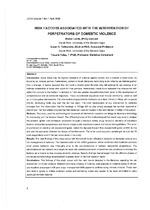| dc.contributor.author | Londt, Marcel P. | |
| dc.contributor.author | Terblanche, Susan S. | |
| dc.contributor.author | Kotze, Theunis | |
| dc.date.accessioned | 2017-05-08T11:46:44Z | |
| dc.date.available | 2017-05-08T11:46:44Z | |
| dc.date.issued | 2006 | |
| dc.identifier.citation | Londt, M. P. et al. (2006). Risk factors associated with the intervention of perpetrators of domestic violence. Journal of Community and Health Sciences 1(1): 3-14 | en_US |
| dc.identifier.issn | 1990-9403 | |
| dc.identifier.uri | http://hdl.handle.net/10566/2816 | |
| dc.description.abstract | INTRODUCTION: South Africa has the highest incidence of violence against women and a woman is killed every six hours by an intimate partner. Furthermore, women in South Africa are more likely to be killed by an intimate partner than a stranger. It seems apparent that not much is known about the men who will continue to use violence in an intimate relationship or those who would kill their partners. International trends have indicated that intervention with either the survivor or the batterer in isolation is futile and greater recognition has been given to the development of comprehensive and co-ordinated responses. These co-ordinated responses must include community, social as well as criminal justice interventions. Yet, intervention programmes for batterers are in their infancy in Africa, with a special interest developing really only over the last five years. The initial development of any intervention for batterers emerged from the observation that the beatings or killings did not stop simply because the survivor received an intervention. Yet the batterer programmes that developed were not always in the best interest or safety of the women. METHODS: This study used the methodological framework of intervention research and design to develop a technology for intervening with the batterer himself. The different phases of this methodological framework was used to analyse the problem, gather and synthesize information through a literature review, study functional elements of successful batterer intervention programmes and then to design a risk-based assessment and intervention guidelines. The writer implemented an existing risk assessment guide, called the Spousal Assault Risk Assessment guide (SARA) to this end and the outcomes informed the design of the framework. The writer used purposive sampling to include the 53 male respondents and 47 female respondents in this study. RESULTS: The main findings of this study concur with the overall trends reflected in literature on domestic violence and the management of batterers. The implementation of the SARA guidelines further confirmed that treatment providers must assess batterers very thoroughly prior to the commencement of batterer intervention programmes. The identification of risk markers must clearly be taken into consideration when programmes are developed to manage the
batterer as a means to stop ongoing domestic violence. Specific findings that emerged from the different phases of the research methodology are presented in greater detail in this final research report.
CONCLUSIONS: The findings of this study concur with the main trends detected in the literature regarding the risk markers for continued violence. Batterers who have a history of violence, were exposed to violence during childhood, are impulsive and present with poor anger management skills appear to continue using intimate violence. Those men who tend to ignore or violate protection orders and restraining orders also appear to be more committed to using continued intimate violence. | en_US |
| dc.language.iso | en | en_US |
| dc.publisher | University of the Western Cape | en_US |
| dc.rights | This journal provides immediate open access to its content on the principle that making research freely available to the public supports a greater global exchange of knowledge. | |
| dc.subject | Safety | en_US |
| dc.subject | Women | en_US |
| dc.subject | Domestic violence | en_US |
| dc.subject | South Africa | en_US |
| dc.subject | Batterers | en_US |
| dc.title | Risk factors associated with the intervention of perpetrators of domestic violence | en_US |
| dc.type | Article | en_US |
| dc.privacy.showsubmitter | FALSE | |
| dc.status.ispeerreviewed | TRUE | |

